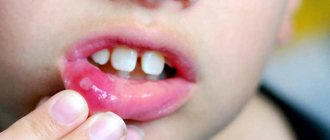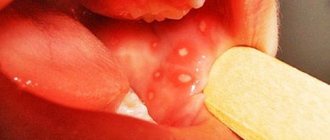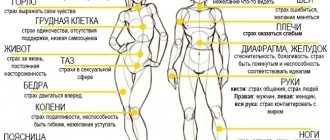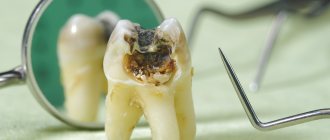The causes of the development of chronic pharyngitis may be:
- improper treatment of acute pharyngitis
- chronic tonsillitis
- chronic diseases of the nose and paranasal sinuses (sinusitis, sinusitis)
- long-term use of vasoconstrictor drops
- irritants, dust, smoke, smoking and alcohol abuse
- diseases of internal organs (cholecystitis, pancreatitis, chronic gastritis and intestinal dysbiosis)
- nasopharyngitis
According to the localization of the process, it is customary to distinguish:
- mesopharyngitis
- nasopharyngitis
- hypopharyngitis
By type, chronic pharyngitis is divided into:
- simple (catarrhal) pharyngitis
- hypertrophic (granular) pharyngitis
- atrophic or subatrophic pharyngitis
Most often, the symptoms of the disease appear after hypothermia of the body, which is why in everyday life nasopharyngitis is often called a cold.
Different types of disease require different therapeutic methods:
- Catarrhal
- Hypertrophic
- Atrophic
- Subatrophic
Analogs
There is no exact analogue of the balm. The following drugs have the same properties:
- Hydrogen peroxide. A strong antiseptic, used to remove dirt and pus from wounds. Is an antioxidant. When treating wounds, foam is formed that closes the vessels and stops bleeding. Used to remove pathogenic microflora from mucous membranes.
- Elekasol. This is a herbal mixture consisting of licorice, chamomile, sage and other plants. Like Shostakovsky's balm, it has an antimicrobial effect and relieves inflammation and tissue swelling well. Used for the treatment of dental, urological, gynecological diseases.
- Iodoform. The powder is used externally only. Wound surfaces are treated; if necessary, the product is diluted for better penetration into closed areas.
- Naftaderm. The ointment is made from naphthalan oil. It is an antiseptic, has a resolving effect, and is used externally. Relieves inflammation, softens tissues.
Other analogues are Methylene blue, Potassium permanganate, Hexicon, Septifril, Pantocid.
The balm is sold without a prescription. The cost of the drug Vinilin is from 100 rubles per 50 ml.
Composition and release form
You can find “Polivinox” on sale, packaged in capsules, as well as bottled in containers (flask, bottle) made of dark-colored glass. Container capacity - 50, 100 g, 1 g of liquid contains 1 g of polyvinyl butyl ether. Another name for the active substance is polyvinox. There are no auxiliary components in the drug.
| Name | Tara | Material | Volume |
| Balm (“Polivinox”) | Bottle | Dark glass | 100 g |
| Balm (“Polivinox”) | Bottle | Dark glass | 50 g |
| "Vinilin" | Bottle | Dark glass | 100 ml |
| "Vinilin" | Bottle | Dark glass | 180 ml |
Upon contact, “Vinilin” has three types of therapeutic effects on mucous tissues:
- epithelializing;
- antimicrobial;
- anti-inflammatory.
The main component of the drug is polyvinox. The active substance is characterized by antimicrobial activity. The bacteriostatic effect of Vinilin first slows down and then completely interrupts the vital activity of pathogenic microflora.
When Vinilin is applied externally, the child’s pain in the throat decreases. The product coats the inflamed mucous membranes of the throat well, this promotes active regeneration processes that begin in the tissues, this leads to a reduction in inflammation.
Instructions for use
Rectal, external and internal use of Vinilin is indicated. Let's consider the basic rules for using the balm for various pathologies.
Externally
According to the instructions for use, Vinilin can be used in pure form or in 20% solutions obtained from substances in which the balm is dissolved. The product is applied to the wound or soaked in gauze pads and applied to the skin.
The surface can be covered for better absorption of the balm. The procedure is carried out 1-2 times a day, closing the wound for 1 hour.
For mastitis, fabric soaked in Vinylin is applied to the seals on the mammary gland and fixed.
For the mucous membranes of the mouth
For stomatitis or other lesions of the oral mucosa, soak a cotton swab on a stick in Vinilin and apply the product to the erosion. This method is used when minor areas of mucous membranes are affected.
Another way to use it for large areas of ulcers is to rinse with the prepared solution. You should treat your mouth 3-4 times a day. In this case, the composition can be swallowed. After application, a protective film is formed on the surface of the mucous membrane, protecting against irritation and accelerating healing.
For children, erosions with stomatitis are carefully lubricated, keeping them from drinking and eating for 1-2 hours
Gastrointestinal pathologies
To treat the mucous membranes of the digestive tract, it is necessary to wait for the maximum emptying of the stomach and ensure prolonged contact with the medicine. Therefore, Shostakovsky balm is taken 5 hours after meals (dinner) at night. On the first day of therapy, the volume of Vinilin is 1 teaspoon. Further:
- For gastritis with increased production of gastric juice, take a dessert spoon of balm every other day for 10-14 days.
- For ulcerative processes of the gastrointestinal tract - 1 dessert spoon per day for 2-3 weeks.
After using the balm, do not eat.
Rectally
External hemorrhoids or anal fissures are simply lubricated with balm or gauze napkins soaked in the product are applied. After applying Vinilin, you need to lie down for 20 minutes.
The drug is applied 3-4 times a day. The entire course lasts from a week to two.
For rectal insertion, a rectoscope or rubber bulb is used. Before administration, the intestines should be emptied. Vinyl should be slightly heated to a warm state, the volume should be at least 25 ml.
The balm helps well with non-advanced hemorrhoids. If the dynamics are positive, the course is completed, and after a week's break the treatment is repeated.
For frequent exacerbations, the balm is also used prophylactically in non-acute periods - once a day at night. The course is a week.
The same therapeutic actions are carried out for dysentery to reduce inflammation of the rectum.
Instructions
The use of medicine for the treatment of stomatitis in children is permitted only after consultation with a specialist. It is important to strictly adhere to the instructions and dosage of the drug. This will help avoid negative health consequences.
In some cases, the drug provokes allergies and manifestations of individual intolerance.
To cope with stomatitis in a child, you need to:
- Prepare a cotton swab, swab or gauze pad. It is important to consider that the affected areas of the oral cavity are treated in good lighting conditions. Therefore, it is better to do this in daylight or near a window. In the evening you will have to use a table lamp.
- It is better to treat the oral cavity of a restless baby together with an assistant who will fix his head .
- Do not forget that pressing on the root of the tongue or placing a finger deep in the mouth can provoke a gag reflex in the child.
- For the effectiveness of vinylin, it is recommended to apply it after each meal. To do this, it is recommended to soak a cotton swab or napkin in the medicine and remove the white plaque that has accumulated in the mouth. Manipulations are carried out at least 3 times a day .
- It is not recommended for young children to lubricate pacifiers with balm. It is important to ensure that the medicine does not enter the baby’s body.
The effect is visible almost on the second day of using the drug - swelling disappears, the baby becomes calmer. But if the result is not visible within a week, stop using the drug.
The medicine is prescribed during teething. It helps prevent the development of stomatitis. To get the desired result, swollen gums are treated with the drug.
The product has a good therapeutic effect. It helps to cope with the disease literally in 2 - 4 days - it all depends on the severity of the disease.
It is recommended to continue treatment with the product after the affected areas have healed. To consolidate the effect, two procedures are enough. If after 3 - 5 days there is no significant improvement, you need to consult a doctor again, who will adjust the course of therapy.
It is important to remember that the balm helps to cope with the manifestations of stomatitis. However, it does not affect the cause of the development of the disease.
To prevent relapses, it is very important to eliminate the factors that provoked the disease. These include weakened or fragile immunity and foci of infections in the body resulting from diseases of the digestive system, tonsillitis, and adenoiditis.
The viral form of stomatitis becomes a consequence of influenza, ARVI, herpes. Against the background of a deficiency of vitamins and minerals, allergic stomatitis and other types of illness often develop.
Find out more about why a tooth may throb and hurt when pressed and what remedies can be used to get rid of the problem. This article provides detailed information on the treatment of bleeding gums during pregnancy.
At this address https://dr-zubov.ru/krasota-i-uxod/narashhivanie/osobennosti-i-ceny-populyarnyx-metodov.html you will learn about the cost of teeth extensions.
Analogues and price of the drug
The drug "Vinilin" has practically no analogues. There are only synonymous drugs that also contain polyvinox as an active ingredient. Such medications include Shostakovsky balm, Polivinox and Polivinin-Rusfar. These drugs can be used as a replacement for the original medicine without prior consultation with a doctor, since they have the same indications, contraindications and side effects.
As for the price, for the drug “Vinilin” it can be different and depends on the volume of the bottle. On average, 50 ml of balm is sold for 200 Russian rubles, and 100 ml - for 290-300 rubles.
Description
Vinilin is used as an antiseptic for sore throats. The balm has a thick and viscous consistency. The medicine is light yellow in color and has a specific odor. The balm is sold in dark glass bottles.
The specificity of the drug is that it does not dissolve in water, but it does not dissolve in oil and alcohol. “Viniline” is also called “Shostakovsky’s Balm”. It acts as a medicine, reduces inflammatory processes, kills microbes, prevents them from actively spreading, cleans abrasions, ulcers, cuts, promotes their healing, and envelops the mucous membrane.
Vinilin has a bacteriostatic effect. The balm is sold in capsules and jars of 100 milliliters. "Vinilin" is a medicine that also has an anti-inflammatory effect. Promotes tissue regeneration, epithelization, stimulates wound healing, cleanses the skin of suppuration. After using it, the stitches heal faster and the scars become less noticeable.
How is Vinilin used?
The drug for the treatment of stomatitis is used in the form of a balm (available in 50 and 100 grams), it is applied to the affected areas in the mouth using a gauze pad. Treatment of the oral cavity with this drug should be carried out after meals. The procedure can be performed on an empty stomach, after which you must not eat or drink for about 40 minutes.
The high therapeutic effect of Vinilin has been proven. After using it for several days, a noticeable improvement in the patient’s general condition is already visible, and unpleasant symptoms disappear.
The procedure is carried out 3 times a day. Vinyline in solution is used for rinsing; the drug in tablet form can only be taken by adults.
Instructions for use of Vinilin
Indications for use
- Carbuncles;
- boils;
- purulent wounds of soft tissues;
- trophic ulcers;
- burns;
- frostbite;
- dermatitis (inflammatory skin diseases);
- strepto-staphyloderma (pustular skin diseases);
- scabies;
- mastitis (purulent inflammation of the mammary gland);
- post-radiation lesions (for cancer);
- haemorrhoids;
- stomatitis (inflammation of the oral mucosa);
- gingivitis (inflammation of the gums);
- glossitis (inflammation of the mucous membrane of the tongue);
- periodontal disease (damage to periodontal tissue);
- irritation of the oral mucosa when using removable dentures;
- leukoplakia (damage to the mucous membrane of the cervix);
- dysentery;
- ulcerative colitis;
- anal fissures (fissures in the anus due to prolonged constipation);
- erosive gastritis;
- Crohn's disease;
- hyperacid gastritis (with high acidity);
- peptic ulcer of the stomach and duodenum;
- erosive gastritis.
Contraindications
Vinylin is not prescribed:
- during pregnancy and breastfeeding;
- in childhood (contraindicated for internal use);
- in case of individual intolerance to Vinilin or its components;
- for kidney diseases;
- for diseases of the liver and gall bladder.
Side effects
If you follow the dosages prescribed by your doctor, there are no side effects.
In case of an overdose of the drug, an allergic reaction may occur in the form of redness, itching or rashes in the form of hives.
Treatment with Vinilin
How to use Vinilin?
Vinylin can be used externally and internally.
For external use
Vinylin is applied to a napkin or directly to the surface of the wound in sufficient quantity.
For external use, Vinilin can be used both in pure form and in the form of a 20% solution in any vegetable oil (sea buckthorn oil, rosehip oil and others) and in the form of an ointment (compatible with other ointments, pastes, creams).
Inside
Vinyline can be taken as a balm (undiluted) 5-6 hours after a light dinner.
Vinyline can also be administered through a proctoscope.
(a special apparatus for examining the large intestine) or with a syringe through a rectal rubber tube (for microenemas).
It can be inserted into the rectum using a rubber bulb
.
In the form of a therapeutic enema, either pure Vinylin or diluted in half with fish oil is administered.
Dosage of Vinilin when taken orally .
1 teaspoon of balm is prescribed on the first day, all subsequent days - 1 dessert spoon 1 time per day; the course of treatment is 15-20 days (for peptic ulcers) or 10-12 days (for severe heartburn or gastritis with increased secretion).
Through a rectoscope
25-40 ml of Vinilin are administered; for microenemas – 15-30 ml; course of treatment up to 10 days; in therapeutic enemas, up to 100 ml (pure Vinilin or with fish oil) is administered 2 times a week for 3-4 weeks.
Indications and contraindications
Vinilin is actively used for the treatment of stomatitis in children. However, the product is used not only in dentistry. The preparation for external treatment can be used in the following cases:
- carbuncles;
- boils;
- burns;
- frostbite;
- trophic ulcers;
- inflammatory processes on the skin;
- purulent wounds.
The use of vinylin usually does not cause side effects. But it is important to consider contraindications to the use of the drug. These include:
- individual intolerance;
- kidney diseases: pyelonephritis, glomerulonephritis;
- pathologies of the gallbladder and liver: hepatitis, cholecystitis, dyskinesia.
It is imperative to take into account that children are prohibited from giving the drug in capsule form. They are only allowed to use vinylin externally.
For children with food or drug allergies, the drug is prescribed very carefully. This can only be done if the child does not have negative reactions to the components of the drug.
Parents should monitor their baby's reactions to vinylin. Any suspicion of the development of an allergy should be a reason to discontinue the drug.
Vinylin
Vinylin instructions
Vinilin is a domestic antiseptic. It has anti-inflammatory, antibacterial, enveloping and regenerating effects. Promotes disinfection of wounds, restoration of tissue integrity, formation of epithelium in places of damage to the skin. Experiments on the synthesis of vinyl esters began back in 1888. Vinilin himself was created by M.F. Shostakovsky in 1941, during the war, when the country experienced an urgent need for anti-inflammatory, antipyretic and anti-burn drugs. The drug, which is also called Shostakovsky’s Balm, is still in use today. It is used for local purulent inflammation of the skin, trophic ulcers, inflammation of the mammary gland, soft tissue damage, temperature damage to the skin (burns, frostbite). Vinilin is used orally for ulcerative-erosive lesions of the stomach and duodenum, inflammation of the mucous membrane of the stomach and large intestine. The drug occupies a special place in solving the problem of burn injuries. A burn wound has a very specific healing process, which determines the tactics of their treatment: local therapy, measures to quickly close the surface of the wound to prevent bacterial contamination and intoxication, activation of epithelium formation on the wound surface
The following requirements are put forward for drugs used to treat burn wounds: bactericidal properties, absence of negative effects on cells and tissues, stability of action upon contact with living tissues, non-volatility, convenience and ease of use (important when providing emergency care). In recent years, many new drugs have appeared for the treatment of burn wounds, however, the high number of allergic reactions and the emergence of antibiotic-resistant strains force one to turn to proven drugs, the clinical effectiveness of which has long been known and is beyond doubt.
One such medicine is Vinilin. It ensures wound healing without complications. In terms of bactericidal activity, Vinilin is somewhat inferior to Levomekol, but is superior to this drug in the speed of wound healing. In addition, dressings with Vinilin can be changed less often than with Levomekol. Vinilin provides brighter and more even granulations and less painful dressing changes. When using Vinilin, wound healing occurs, as a rule, without peripheral inflammation. Due to the elasticity of the bandage, pain is usually less severe than with other medications. A characteristic feature of the drug is a slight burning sensation under the bandage, which lasts about 15-20 minutes after the first application. Vinilin has a specific odor, to which patients quickly get used to, and the deodorizing effect of the drug subsequently becomes even pleasant. Vinylin can be applied to the skin using sterile medical wipes, or directly to the skin directly from the bottle. It is planned to release Vinilin in the form of an aerosol, which will minimize losses when directly applying the drug to the skin and eliminate the inconvenience of its distribution over the skin. The frequency of use of the drug is 3-5 times a day. Undesirable side effects are allergic reactions in the form of skin rashes. Contraindications for use are individual intolerance to the components of the drug, as well as pregnancy and lactation (for oral administration only).
Contraindications for the drug Vinilin
- Children's age up to 14 years.
- Kidney and liver diseases.
- Individual intolerance to some components of the drug.
But very often dentists prescribe a balm for stomatitis for children who have not yet turned 14 years old. It is important that the child is not able to swallow the medicine. In addition, you need to carefully monitor the baby's condition: if you see the slightest rash, stop using the drug and show the child to the doctor.
Keep in mind that Vinilin can only eliminate the unpleasant manifestations of stomatitis; the causes of the development of the disease are hidden deeper. It is for this reason that you cannot treat with balm yourself. It is better to seek help from a dentist and pediatrician.
Features of use
Despite contraindications for the use of ointment before the age of 14, dentists often prescribe it for the treatment of stomatitis in children. You just need to follow the dosage and all the doctor’s recommendations.
The ointment should be used with extreme caution in children who are prone to allergies. In case of the slightest manifestation of an allergic reaction, you must stop using the drug, even if it copes well with the symptoms of the disease.
Often ointment is prescribed for the treatment of candidal stomatitis in infants. In this case, it is imperative to monitor the condition of the baby and follow the dosage.
Indications
Vinylin is used:
- If the skin or soft tissue becomes infected, for example with a boil or abscess.
- For trophic skin ulcers.
- For dermatitis.
- For various injuries (for example, abrasions and bruises).
- For open wounds on the skin.
- From diaper rash.
- For chemical or thermal burns.
- For post-traumatic infection.
- For anal fissure and hemorrhoids.
- For chickenpox (to treat blisters in the mouth).
- With frostbite.
- For sore throat, granulosa pharyngitis and other infections of the throat and tonsils.
- For stomatitis, gingivitis, glossitis and other lesions of the oral mucosa.
The medicine is taken orally for high acidity and heartburn (erosive or hyperacid gastritis), peptic ulcer or ulcerative colitis. Comprehensive treatment of such diseases is necessary. The solution injected using a rectoscope is used for colitis and dysentery.
Hypertrophic pharyngitis
For hypertrophic pharyngitis
The patient's complaints are similar to those with the catarrhal form of the disease, but in this case
there is more mucous discharge and it is more viscous
, which causes discomfort, since it is necessary to constantly cough up, which can provoke an attack of vomiting.
With this type of pharyngitis, there are lymphoid accumulations (groups of follicles) on the mucous membrane of the pharynx, which are pronounced.
In case of large accumulation and increase in size, these follicles turn into granules, and the disease is designated as granulosa chronic pharyngitis.
For hypertrophic pharyngitis, alkaline gargling is also recommended; inhalations with essential oils of medicinal herbs (sage, chamomile and eucalyptus) are also useful.
Hypertrophic granulosa pharyngitis
has a characteristic symptom - a tickling sensation in the throat, its other symptoms are similar to those of hypertrophic pharyngitis.
Treatment of granulosa pharyngitis
can be therapeutic and surgical
Therapeutic
– similar to the treatment of catarrhal chronic pharyngitis.
Surgical
the intervention is carried out using a radio wave or laser beam. During surgery, the granules themselves are removed, but to completely cure the pathology, therefore, after removal of the granules, drug treatment is still required.
The patient should stop smoking.
Contraindications and side effects
The manufacturer does not guarantee the complete absence of side effects from the use of Vinilin. The reasons for their appearance in most cases are associated with incorrect dosage of the medicine. The annotation for the medicine states that it is not recommended for children. However, medical practitioners note the positive effect of the balm on babies. In case of an overdose, a child may develop consequences in the form of allergic skin rashes:
- the skin turns red;
- itches;
- rashes appear.
Such side effects are typical for children who are intolerant to the medicinal components included in the drug. Allergies are manifested by dermatological changes. In addition to itching and redness, the child may experience swelling.
No other adverse reactions were detected with the balm. The active substance does not penetrate tissue cells and does not have a toxic effect on the body. There is a list of pathologies for which Vinilin is not recommended:
- kidney disease;
- liver pathologies;
- gallbladder diseases.
Atrophic pharyngitis
Atrophic pharyngitis is the final stage of chronic pharyngitis. In addition, this disease can occur independently against the background of dystrophic diseases of the gastrointestinal tract.
With atrophic pharyngitis, the mucous secretion becomes very viscous and dries into crusts, which cause significant discomfort to the person - they are located in the nasopharynx, from where they are released in fragments or whole casts.
With atrophic pharyngitis, the mucous membrane of the pharynx is dry and pale, blood vessels are clearly visible through it, lymphoid granules consist of scar connective tissue.
The pharyngeal reflex may completely disappear, which indicates that atrophic pharyngitis affects the nerve endings.
Treatment of atrophic pharyngitis is long-term, its effectiveness depends on the degree of atrophy, the general condition of the body and the cause that led to the occurrence of this pathology.
Atrophic pharyngitis
has two directions in treatment - general and local.
Local treatment
atrophic pharyngitis is aimed at increasing the activity of the glandular apparatus of the pharyngeal mucosa, which should lead to increased production of mucus and an increase in reparative biologically active substances in it.
General treatment
atrophic pharyngitis is aimed at increasing immunity.
Self-medication will not help. It is ineffective and dangerous
Release forms
| Dosage | Packing | Storage | Sale | Best before date |
50; 100
Short description
Vinilin is a domestic antiseptic. It has anti-inflammatory, antibacterial, enveloping and regenerating effects. Promotes disinfection of wounds, restoration of tissue integrity, formation of epithelium in places of damage to the skin. Experiments on the synthesis of vinyl esters began back in 1888. Vinilin himself was created by M.F. Shostakovsky in 1941, during the war, when the country experienced an urgent need for anti-inflammatory, antipyretic and anti-burn drugs. The drug, which is also called Shostakovsky’s Balm, is still in use today. It is used for local purulent inflammation of the skin, trophic ulcers, inflammation of the mammary gland, soft tissue damage, temperature damage to the skin (burns, frostbite). Vinilin is used orally for ulcerative-erosive lesions of the stomach and duodenum, inflammation of the mucous membrane of the stomach and large intestine. The drug occupies a special place in solving the problem of burn injuries. A burn wound has a very specific healing process, which determines the tactics of their treatment: local therapy, measures to quickly close the surface of the wound to prevent bacterial contamination and intoxication, activation of epithelium formation on the wound surface
The following requirements are put forward for drugs used to treat burn wounds: bactericidal properties, absence of negative effects on cells and tissues, stability of action upon contact with living tissues, non-volatility, convenience and ease of use (important when providing emergency care). In recent years, many new drugs have appeared for the treatment of burn wounds, however, the high number of allergic reactions and the emergence of antibiotic-resistant strains force one to turn to proven drugs, the clinical effectiveness of which has long been known and is beyond doubt.
One such medicine is Vinilin. It ensures wound healing without complications. In terms of bactericidal activity, Vinilin is somewhat inferior to Levomekol, but is superior to this drug in the speed of wound healing. In addition, dressings with Vinilin can be changed less often than with Levomekol. Vinilin provides brighter and more even granulations and less painful dressing changes. When using Vinilin, wound healing occurs, as a rule, without peripheral inflammation. Due to the elasticity of the bandage, pain is usually less severe than with other medications. A characteristic feature of the drug is a slight burning sensation under the bandage, which lasts about 15-20 minutes after the first application. Vinilin has a specific odor, to which patients quickly get used to, and the deodorizing effect of the drug subsequently becomes even pleasant. Vinylin can be applied to the skin using sterile medical wipes, or directly to the skin directly from the bottle. It is planned to release Vinilin in the form of an aerosol, which will minimize losses when directly applying the drug to the skin and eliminate the inconvenience of its distribution over the skin. The frequency of use of the drug is 3-5 times a day. Undesirable side effects are allergic reactions in the form of skin rashes. Contraindications for use are individual intolerance to the components of the drug, as well as pregnancy and lactation (for oral administration only).
Pharmacology
A product that improves tissue regeneration with an anti-inflammatory effect. It also has an antimicrobial, local anti-inflammatory and enveloping effect.
When used externally, it promotes wound cleansing, epithelization, and tissue regeneration.
Release form
| Balm | 1 fl. |
| polyvinox | 100 % |
50 g - bottles (1) - cardboard packs. 100 g - bottles (1) - cardboard packs. 50 g - bottles (50) - cardboard boxes. 100 g - bottles (50) - cardboard boxes.
Dosage
Apply externally by wetting wipes or applying directly to the wound surface.
When taken orally, a single dose is 1.4 g, frequency of administration is 3-5 times a day.
Indications
For external use: boils, carbuncles, trophic ulcers, purulent wounds, mastitis, soft tissue injuries, burns, frostbite, inflammatory skin diseases.
For oral administration: peptic ulcer of the stomach and duodenum, gastritis, colitis.
Instructions for use of Vinilin
Side effects
If you follow the dosages prescribed by your doctor, there are no side effects.
In case of an overdose of the drug, an allergic reaction may occur in the form of redness, itching or rashes in the form of hives.
Treatment with Vinilin
How to use Vinilin?
Vinylin can be used externally and internally.
For external use
Vinylin is applied to a napkin or directly to the surface of the wound in sufficient quantity.
For external use, Vinilin can be used both in pure form and in the form of a 20% solution in any vegetable oil (sea buckthorn oil, rosehip oil and others) and in the form of an ointment (compatible with other ointments, pastes, creams).
Inside
Vinyline can be taken as a balm (undiluted) 5-6 hours after a light dinner.
Vinyline can also be administered through a proctoscope.
(a special apparatus for examining the large intestine) or with a syringe through a rectal rubber tube (for microenemas).
It can be inserted into the rectum using a rubber bulb
.
In the form of a therapeutic enema, either pure Vinylin or diluted in half with fish oil is administered.
Dosage of Vinilin when taken
orally
: 1 teaspoon of balm is prescribed orally on the first day, all subsequent days - 1 dessert spoon 1 time per day; the course of treatment is 15-20 days (for peptic ulcers) or 10-12 days (for severe heartburn or gastritis with increased secretion).
Through a rectoscope
25-40 ml of Vinilin are administered; for microenemas – 15-30 ml; course of treatment up to 10 days; in therapeutic enemas, up to 100 ml (pure Vinilin or with fish oil) is administered 2 times a week for 3-4 weeks.
Recommendations for use
Treat the affected areas immediately after eating. For preschoolers, schoolchildren and teenagers, this is best done in the morning on an empty stomach. Eating is allowed 40 minutes after the procedure. In infants, treatment is carried out 1.5 hours after feeding.
The instructions indicate that vinylin can also be used for rinsing. Thanks to this, it is possible to evenly distribute the drug over the surface of the mucous membrane.
It is important to remember that swallowing the medicine is strictly prohibited. Therefore, only preschool children and adolescents can use this treatment option.
Doctors recommend using the drug in combination with other medications. Thanks to this, the effectiveness of therapy can be increased. However, specific medications should only be prescribed by a doctor after a thorough diagnosis.
So, for mild stomatitis, it is enough to treat the oral cavity with vinylin and use decoctions of medicinal herbs for rinsing.
If the disease has a more complex course, antibacterial agents can be used.
If a child is diagnosed with stomatitis of viral origin, it is recommended to use vinylin very carefully only after prescription by a specialist.
In addition, the doctor may prescribe antiviral agents for external and internal use.
It is important to maintain hygiene, include more vitamins in the baby’s diet and regularly treat the oral cavity with antibacterial drugs.
It is important to remember that viral stomatitis is spread by airborne droplets. Therefore, the child should remain at home until complete recovery. It is advisable to use a mask when speaking.
Best before date
The product is sold in pharmacies without a prescription. In accordance with the recommendations in the instructions, it must be stored at room temperature, with the lid tightly closed. This is the only way the shelf life of the medicine Vinilin reaches 5 years.
Vinilin is an indispensable antiseptic for the throat in the treatment of sore throat. It not only kills dangerous bacteria, but restores the mucous membrane, heals wounds and abrasions. We should not forget that the drug is not an independent medicine and is used only as an adjunct for the treatment of sore throat.
You need to keep Vinilin at home at a temperature below 25 degrees Celsius. The drug should be stored in a place hidden from children, and its bottle should always be tightly closed. The shelf life of the medicine is 5 years.
Vinilin has an antiseptic effect, helps cleanse wounds, delays the development and growth of pathogenic microbes, reduces pain, and has a wound-healing effect (promotes tissue regeneration and promotes the formation of a soft scar at the wound site).
ATX code: D03A X50. Antiseptic drugs.
Store in tightly sealed containers; capsules are stored in a dry place at a temperature not exceeding 30° C. Available without a prescription.
The shelf life of Vinilin is 5 years.
Store at room temperature. Keep away from children.
Five years.
Effect of the balm
“Vinilin” for stomatitis is most effective in treating its infectious and traumatic forms. The drug helps to disinfect the mucous membranes of the mouth, preventing the entry of new harmful microorganisms into infected areas. In addition, Shostakovsky balm promotes epithelial regeneration and restoration of the oral mucosa, which significantly speeds up the healing process.
Balm in the treatment of stomatitis effectively helps relieve pain. Due to the fact that the balm is able to envelop the mucous membrane, it protects it from further damage. A similar effect appears on the gastric walls during gastritis and ulcers, which significantly reduces the risk of developing allergic stomatitis.
“Vinilin” for stomatitis in adults of infectious or traumatic origin is not used as an independent drug, but is part of complex therapy. It is recommended to combine it with rinsing the mouth with herbal infusions; this approach speeds up the healing process and improves the patient’s well-being. In addition to the fact that the balm cleanses and disinfects ulcers well, it also creates a film on the oral mucosa, protecting it from bacteria and relieving pain.
According to the instructions for Vinilin, for stomatitis its effect can be increased through the use of other medications, but the decision on the prescription must be made by the attending physician. For mild cases of the disease, Shostakovsky's balm can relieve stomatitis in combination with herbal rinses. In more severe forms, the drug requires supplementation with other drugs, in particular antibiotics.
Another important point is that stomatitis can be a symptom of another, more serious disease. Oral ulcers may indicate pathology of hormonal, immune and oncological diseases.
Advantages of the drug "Vinilin" for the treatment of stomatitis
Vinilin (also known as Shostakovich's Balm) is an effective remedy that has an antiseptic, antimicrobial and restorative effect. Its active ingredient is polyvinox.
Vinylin in the treatment of stomatitis performs the following tasks:
- disinfects the oral mucosa;
- accelerates the restoration of damaged tissues and speeds up healing;
- relieves pain;
- prevents the possibility of a new infection entering the damaged mucosa.
Vinilin tends to envelop the oral mucosa with a special protective film; the same situation occurs in the stomach. This way you can prevent the occurrence of allergic complications due to stomatitis.
When using the drug in combination with other drugs, the effect of treatment can be greatly increased. But only a doctor should prescribe any medications, after tests have been taken and an accurate diagnosis has been made.
For example, in the case of mild stomatitis, it is enough to use Vinilin and rinse the mouth with a decoction of herbs. In case of complex disease, the dentist may add antibacterial agents.
The drug Vinilin is available in several forms:
- solution;
- pills;
- balm.
Instructions for use of vinylin
Short description
Vinilin is a domestic antiseptic. It has anti-inflammatory, antibacterial, enveloping and regenerating effects. Promotes disinfection of wounds, restoration of tissue integrity, formation of epithelium in places of damage to the skin. Experiments on the synthesis of vinyl esters began back in 1888. Vinilin himself was created by M.F. Shostakovsky in 1941, during the war, when the country experienced an urgent need for anti-inflammatory, antipyretic and anti-burn drugs. The drug, which is also called Shostakovsky’s Balm, is still in use today. It is used for local purulent inflammation of the skin, trophic ulcers, inflammation of the mammary gland, soft tissue damage, temperature damage to the skin (burns, frostbite). Vinilin is used orally for ulcerative-erosive lesions of the stomach and duodenum, inflammation of the mucous membrane of the stomach and large intestine. The drug occupies a special place in solving the problem of burn injuries. A burn wound has a very specific healing process, which determines the tactics of their treatment: local therapy, measures to quickly close the surface of the wound to prevent bacterial contamination and intoxication, activation of epithelium formation on the wound surface
The following requirements are put forward for drugs used to treat burn wounds: bactericidal properties, absence of negative effects on cells and tissues, stability of action upon contact with living tissues, non-volatility, convenience and ease of use (important when providing emergency care). In recent years, many new drugs have appeared for the treatment of burn wounds, however, the high number of allergic reactions and the emergence of antibiotic-resistant strains force one to turn to proven drugs, the clinical effectiveness of which has long been known and is beyond doubt.
One such medicine is Vinilin. It ensures wound healing without complications. In terms of bactericidal activity, Vinilin is somewhat inferior to Levomekol, but is superior to this drug in the speed of wound healing. In addition, dressings with Vinilin can be changed less often than with Levomekol. Vinilin provides brighter and more even granulations and less painful dressing changes. When using Vinilin, wound healing occurs, as a rule, without peripheral inflammation. Due to the elasticity of the bandage, pain is usually less severe than with other medications. A characteristic feature of the drug is a slight burning sensation under the bandage, which lasts about 15-20 minutes after the first application. Vinilin has a specific odor, to which patients quickly get used to, and the deodorizing effect of the drug subsequently becomes even pleasant. Vinylin can be applied to the skin using sterile medical wipes, or directly to the skin directly from the bottle. It is planned to release Vinilin in the form of an aerosol, which will minimize losses when directly applying the drug to the skin and eliminate the inconvenience of its distribution over the skin. The frequency of use of the drug is 3-5 times a day. Undesirable side effects are allergic reactions in the form of skin rashes. Contraindications for use are individual intolerance to the components of the drug, as well as pregnancy and lactation (for oral administration only).
Pharmacology
A product that improves tissue regeneration with an anti-inflammatory effect. It also has an antimicrobial, local anti-inflammatory and enveloping effect.
When used externally, it promotes wound cleansing, epithelization, and tissue regeneration.
pharmachologic effect
What is the drug "Vinilin"? Instructions and reviews from doctors indicate that this is a medicinal product that has an antimicrobial, enveloping and anti-inflammatory effect. When used externally, the medication helps cleanse and heal ulcers and wounds.
The antimicrobial effect of the drug manifests itself in inhibiting the development and growth of bacteria. The healing effect of the drug is associated with regenerative and enveloping properties.
When using the balm, scars remaining after healing of wounds and ulcers remain soft and almost invisible. It should also be noted that the drug in question acts as a local anesthetic.
How does Vinilin balm work when taken orally? Reviews from experts say that this drug has enveloping, anti-inflammatory and bacteriostatic properties. In this regard, it is very often used to treat gastrointestinal diseases.
This medication has a specific pungent odor. It is insoluble in water, but mixes quite well with ethyl ether, liquid paraffin, oils, chloroform, butyl and isoamyl alcohols.
It should also be noted that the balm does not thicken in air and does not dry out.










